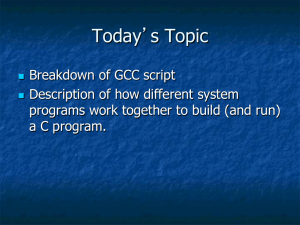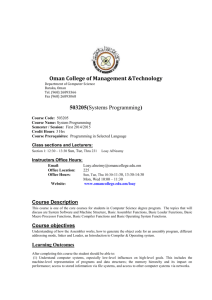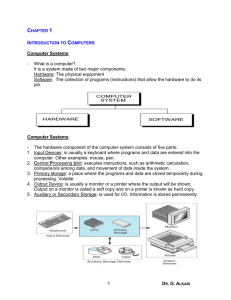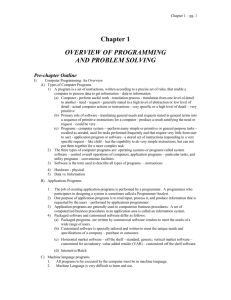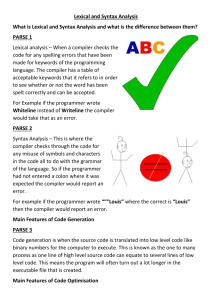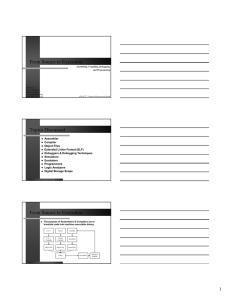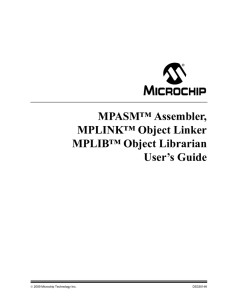Embedded System Software Development
advertisement
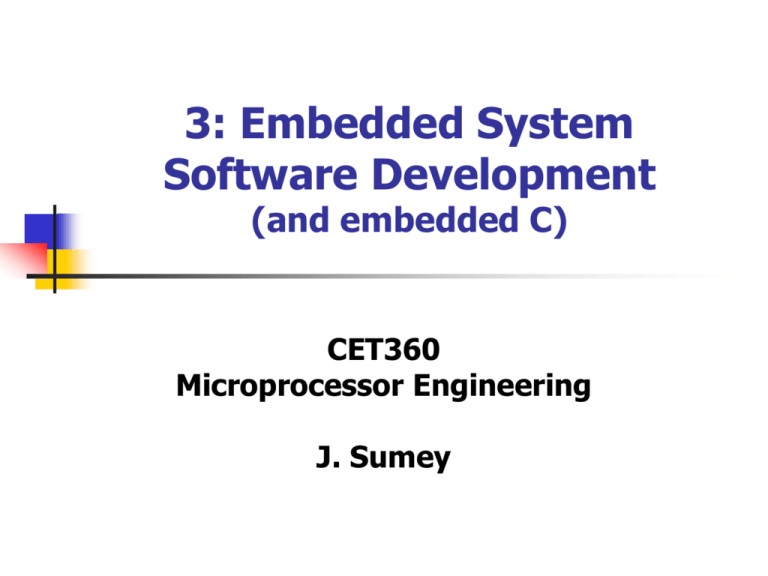
3: Embedded System
Software Development
(and embedded C)
CET360
Microprocessor Engineering
J. Sumey
E.S. Dev. Scenario 1
use existing h/w (COTS)
dev. board, EVB, generic PC
removes h/w problems
more s/w support available
ex: Arduino, Raspberry Pi, NI RIO
monitor, libraries, examples
may be overkill for a given app.
2
E.S. Dev. Scenario 2
h/w co-design
tailored to app. requirements
adds delay of bringing up h/w
additional complexity of debugging h/w
typically requires use of emulation
techniques & support equipment
more cost-effective
3
Software Dev. Process
modern PC-based approach "hides"
many details
issues:
ok for PC environment, not for E.S.!
cross-compilation / assembly
runtime libraries
linking loader (memory map)
diagram…
4
Compilation Process
source code
includes,
defines
Pre-processor
Listing
Compiler
Listing
Assembler
Listing
options
libraries*,
other modules
Linker
executable
*including RTE
Map
R.T.E. & Libraries
HLLs provide only a subset of desired
functions
i.e.: convert an IF-THEN-ELSE construct to
processor-specific machine code
what about run-time environment &
non-intrinsic functions?
ex: who calls main() ?
ans: support libraries
or startcf.c in CodeWarrior Coldfire projects
6
Run-time Library
provide additional functions & services
beyond HLL
CPU dependent – simply manipulate data
structures or perform math
I/O dependent – must match E.S. actual h/w
system services – allocate memory, task control,
etc.
entry/exit – performs setup/cleanup functions
before & after running main()
ex: stack, global initializers, files
7
C Development Steps
1.
2.
3.
4.
5.
pre-processor
compiler
assembler
linker
loader
8
1: Pre-processor
prepares source code for compilation
include files, constant defs, type defs,
library functions, conditional compilation
commands:
a) #define id [string]
"replacement", used to define constants
typically all caps
ex: #define TRUE 1
9
Preprocessor commands…
b) #define MACRO()
adds expression with parameters
ex: #define SQR(x) (x * x)
caution: use parentheses as expression guards!
ex: #define PI 3+1/7
:
twopi = 2 * PI;
above SQR macro needs fixed!
a neat trick:
#define FOREVER while(1)
also: #undef id
10
Preprocessor commands…
c) #include <filename> | "filename"
header file inclusion (.h files)
the interface to library routines
<…> means use system path
"…" means user-defined path
typically use for project-specific header files
CodeWarrior path settings
project Properties C/C++ Build Settings
Compiler Input
11
Preprocessor commands…
d) #ifdef / #ifndef id
conditionally includes code based on existence
of previous #define's
ex:
#ifdef ARDUINO
#define MAXINT 32767
#else
#define MAXINT 2147483648
#endif
12
Preprocessor commands…
e) #if expr
conditionally includes code based on constant
result of expression (no program variables!)
ex:
#ifdef RAMSIZE > 1024
char SCIbuf[800];
#else
char SCIbuf[128];
#endif
13
2: Compiler
translates HLL source code to either assembly
source or direct object code
supports multiple source modules
object code is "intermediate" & becomes input to
the linker
typically has many features
native- vs. cross-compiler
controlled by ES programmer
may also provide optimization
time and/or space, ex…
14
3. Assembler
def: a program which takes the mnemonic
form of a processor's instructions and
converts into a binary object code equivalent
a "machine language compiler"
frees programmer of knowing opcodes,
hex/binary but still requires intimate
knowledge of a machine's architectural details
ex: D=A:B on S12
15
Assembler Operations
convert mnemonics to opcodes
assigns memory addresses to
mnemonics & labels
evaluates & assigns operands
using addressing mode rules
generates object code file and/or
listing, symbol table
16
Assembler "Commands"
a) mnemonics: symbolic names of CPU
opcodes
b) pseudo-ops: directives to the
assembler that affect assembly process
process – if, base, end
memory allocation – org, ds/rmb, dw/fdb
listing control – page
17
Assembler "Commands"
c) macro instructions: a programmerdefined "instruction" which represents
a predefined sequence of other
instructions (body), possibly with
arguments
macro definition vs. macro expansion
ex: BSET MACRO
18
4. Linker
converts "generic" (relative) object code
modules into executable (ready to execute)
form
combines multiple programmer-defined
modules (compilation units) plus library
routines
resolves external references
ex: library function calls
assigns entities to final memory locations
(absolute)
ES programmer must control this step too!
Controlled via “linker control file”
19
5: Loader
takes care of loading executable into
memory and resolving all physical
memory locations
for embedded systems, this normally
entails programming of non-volatile
memory
EPROM, EEPROM, Flash
20
HLL Issues for
Embedded Systems
i.e.: "C Extensions for Embedded
Systems Development"
The "Issues"
physical location assignment?
in-line assembly?
interrupt service routines (ISRs)?
vectors / vector table?
memory map assignment?
22
Physical Location Assignment
programmer-defined assignment of
identifiers to physical locations
ex:
DDRA=0xFF;
a) as an absolute variable
char ddrA @ 0x04; // compiler-specific
b) as a pointer define - more generic
#define DDRA (*(char *)0x04)
23
Volatile Variables
what about "variables" that are actually
control or I/O registers which can change
"on their own"?
ex: waiting for portA input to change
the C qualifier volatile tells the compiler to
make no assumptions about the var
and thus, no optimizations!
ex:
#define PORTA (*(volatile char *)0x00)
24
In-line Assembly
used for full programmer control of CPU
timing-sensitive situations
take full advantage of target CPU features
ex: CLI, SEI
a) a single in-line instruction statement
asm <assembly instr.>; <comment>
b) "instruction" may also be a block
asm {
:
};
ex: "upper()" function…
25
ISRs/Exception Handlers
normal C functions end in RTS but ISRs
must use RTI/RTE! how?
typically via use of a compiler feature
a) using the non-standard interrupt keyword
interrupt void Timer_ISR()…
b) using a #pragma; CodeWarrior ex:
#pragma TRAP_PROC
void Timer_ISR()
{…}
26
Vectors
linker normally takes care of reset
vector, pointing it to “_Startup()”
which calls main()
_Startup() part of C runtime environment
Q: what about other interrupt vectors?
A: handled by interrupt option or VECTOR
option in the linker parameter file
also written by ES programmer
also compiler-specific
27
Memory Map Assignment
placement of code/data/etc. is crucially
important in ES engineering
Q: how does ES programmer specify
where data (RAM) & code (ROM) gets
assigned?
A: handled by PLACEMENT or MEMORY
option in the linker parameter file
28
ES Example
ONE.C – C implementation of ONE.ASM
continuously increment output port as an
8-bit binary up counter
exhibits:
one.c source listing
outputs from preprocessor & compiler
linker parameter file
map file output from linker
29
ES Application
Development Tools
i.e.: "Tools of the Trade"
ES Development Scenarios
previously: we used an editor and
cross-assembler on a host PC then
downloaded/executed on an EVB
ok if EVB has sufficient support including
communication & monitor
many ES development scenarios do not
have these luxuries!
so, we use other tools…
31
ES Development Tools
1. Simulator
a software tool that mimics the operation
of the target microcontroller
pros: don't need actual target h/w
cons: don't have actual target h/w
execution is non-realtime
actual I/Os not present
32
ES Development Tools
2. In-Circuit Simulator (ICS)
a simulator, as above, with h/w interfaces
that allow connection to actual application
circuitry
actual I/O now present
still not realtime execution
33
ES Development Tools
3. Emulator / In-Circuit Debugger (ICD)
a realtime development tool based on
actual MCU target
executes instructions as will be executed in
final application
may implement target ROM as RAM
includes circuitry / MCU support for h/w
breakpoints
may include bus-state analysis features
34
ES Development Tools
4. Programmer / Burner
converts s/w into firmware via
programming into non-volatile memory
EPROM, EEPROM, FLASH, OTP
may be on-board MCU or in external ICs
35
ES Development Tools
5. Logic Analyzer
an expensive, multi-channel digital storage
scope with sophisticated triggering and
display capabilities
can capture/display all MCU activity
before/after a particular event of interest
typically used with conventional bus-type
processors
36
Agilent 68-channel Logic Analyzer


